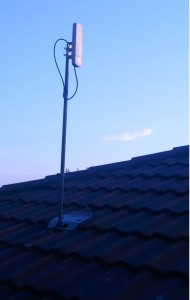When I just moved into my place at Springfield Lakes in January 2012 I rang Telstra to get Internet connected and they said it was unavailable, not enough ports available within my local DA (Distribution Area). I’m on DA96 connected to the Goodna exchange.
 Anyhow, I was told to ring back in a month and check. That was not acceptable. I could not believe in this day and age that basic Internet access was not available to everyone, so I started to research my options. I have a radio tower about 800 metres from me, direct line of sight so worst case scenario I could use 3G. Another option I found was a private company called Puddlenet Communications that has filled the void of DSL with a 5 GHz wireless mesh network.
Anyhow, I was told to ring back in a month and check. That was not acceptable. I could not believe in this day and age that basic Internet access was not available to everyone, so I started to research my options. I have a radio tower about 800 metres from me, direct line of sight so worst case scenario I could use 3G. Another option I found was a private company called Puddlenet Communications that has filled the void of DSL with a 5 GHz wireless mesh network.
Once I found out about Puddlenet I looked further into it and then started looking at the homes in my area and I noticed that a lot of homes had 5 GHz directional antennas, so it was obvious that there were a lot of people in the same situation as me. The only problem with Puddlenet was their plans, like 3G is expensive with limited data allowances.
So I got back onto Telstra and rang them up every second day. It took me two weeks before they said I could get connected. Someone in my area must have so I was lucky enough to get a connection. To the right here is a picture of one of the antennas that people around here have. I took this picture of my neighbours house.
You could image how slow ADSL1 is when you are use to at a minimum ADSL2+. I’m happy to have ADSL2+ but I can’t wait until the NBN is rolled out in this area. The only reason I was able to get ADSL2 was because the NBN is not planned in my area for at least another 3 years so Telstra decided to upgrade this area as part of their Top Hat project.
Here are the results of my before and after speed tests along my with my modems synchronisation speeds.
One thing I will say about Telstra is that as soon as I saw the Top Hat spreadsheet from Telstra Wholesale say that my DA was upgraded I rang them that morning and within 1 hour my speed had changed. Telstra did tell me that it would take 3-4 days for the change to take effect. They were wrong there, but I’m happy about it.


G’dayThe draft legislation cteraing a wholesale organisation with ministerial discretion to allow the sale of services to specific government departments does not make for a new telstra . It was a mistake politically, but given their unique needs, the idea of the NBN providing special deals to federal govt departments is that harmful to the overall industry (and better than in house ISP’s being developed either). The new NBN is nothing like such a threat, and if managed properly will ensure that there is great incentive to built a world class broadband infrastructure, something the bush and big business have been crying out for, for years. Secondly, if you know your history you’ll see that Telstra’s monopoly was the reason we have slow internet in this country. The technology and capability were here years before much of the world, but with internet users having very little choice and profits rising, Telstra used the tech boom years not to upgrade but to sit complacent. Thankfully a number of ISP’s have sprung up and the ACCC (sometimes against the wishes of the government) has forced Telstra to somewhat open the market (ie at least selling them wholesale prices below what Telstra charges its retail customers) which is finally and reluctantly forcing Telstra to invest in the market. This was the fundamental problem with turning a government owned monopoly into a private monopoly, had the Howard Government done that, they would have probably gained a lot of labor support.As for picking winners, well sure but all governments do, and it’s not a bad thing either if done right. We picked winners (via tariffs) at the start of the 20th century as we built up a farming sector, and we picked winners (via regulation/tax breaks) at the end of the 20th century as we expanded our mining sector. Hopefully we will pick winners in encouraging the many innovators in green and high tech industries to stay in Australia, rather than heading overseas as so many have to. When governments try and support industries that are obviously unsustainable (say cars) then there is a significant problem, and when they do this through distorting and harmful means (such as tariffs) then there is also a problem. But when there are clearly developing niche market areas that government merely aids along, the country and the people benefit. If nothing else it may be the minimum these days to ensure many industries even have a chance. Still it’s worth noting that historically it has been Labor during Whitlam and then Hawke/Keating which got rid of the vast majority of tariffs in this country, and that Rudd has not added any new ones, nor substantively changed any industry support from how it was configured under Howard, so your characterization of Labor is wrong. It supports the free market as much (if not more so ie ETS/means testing private health insurance etc) than the Coalition.Thanks for your comments.